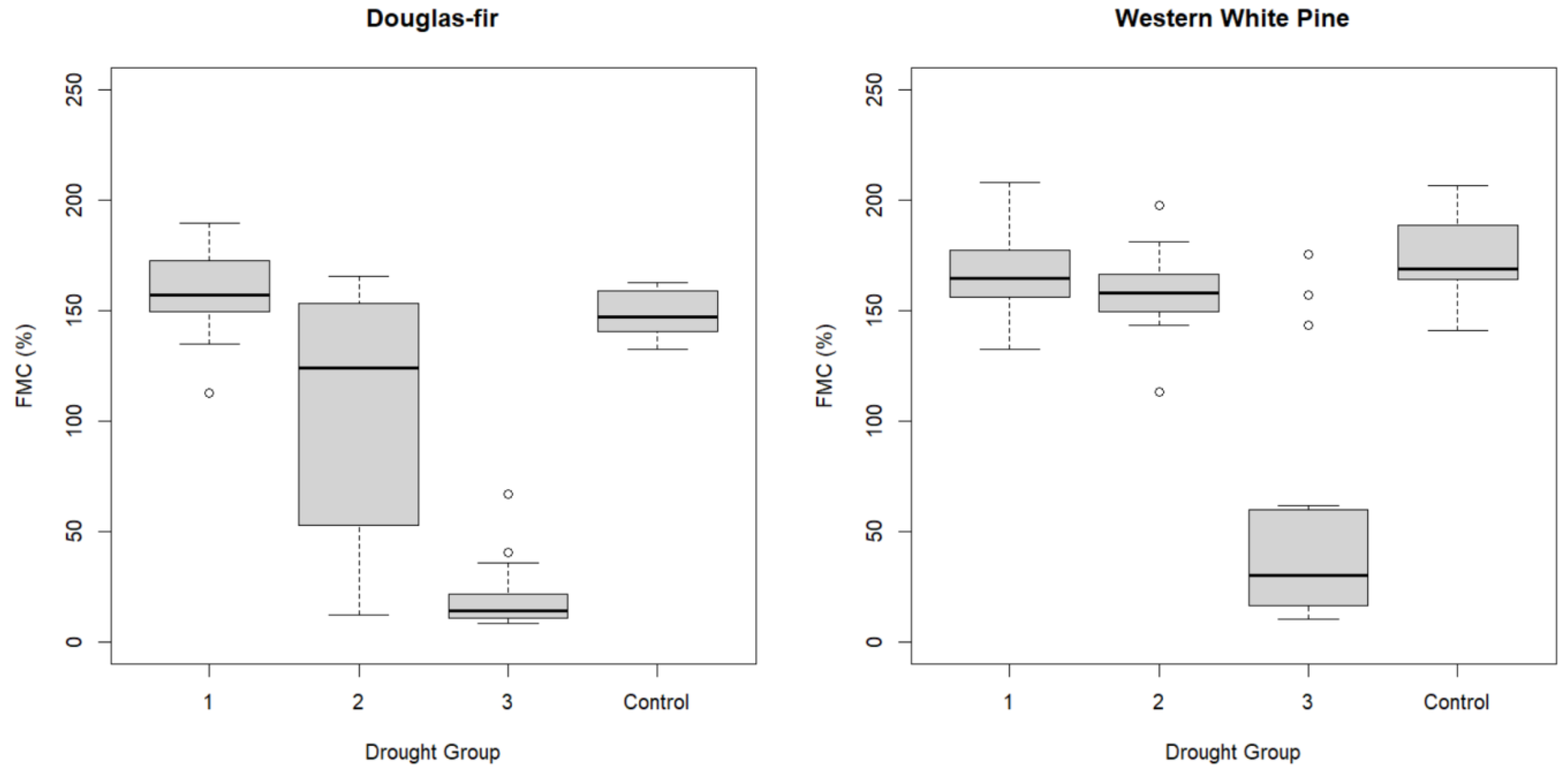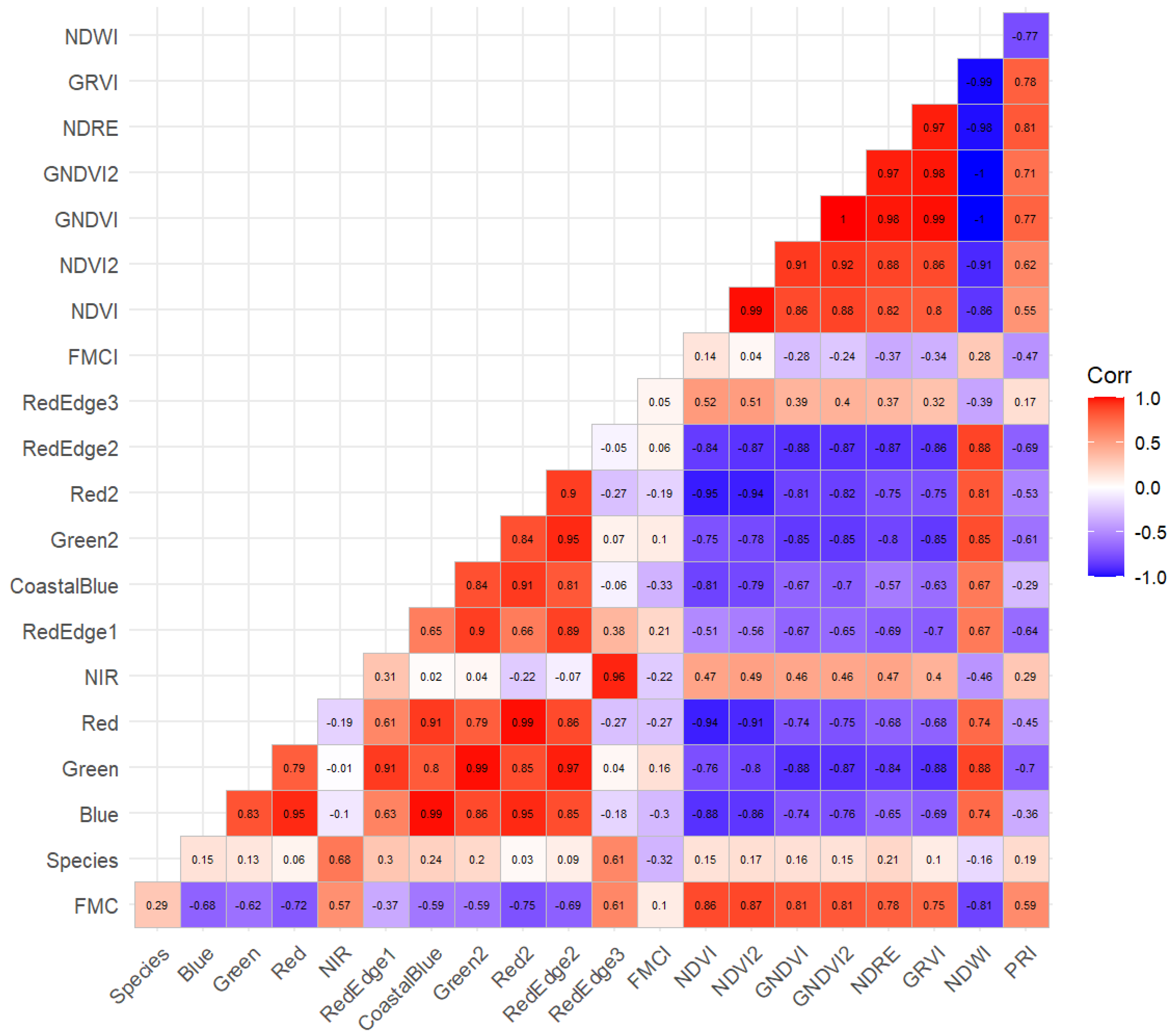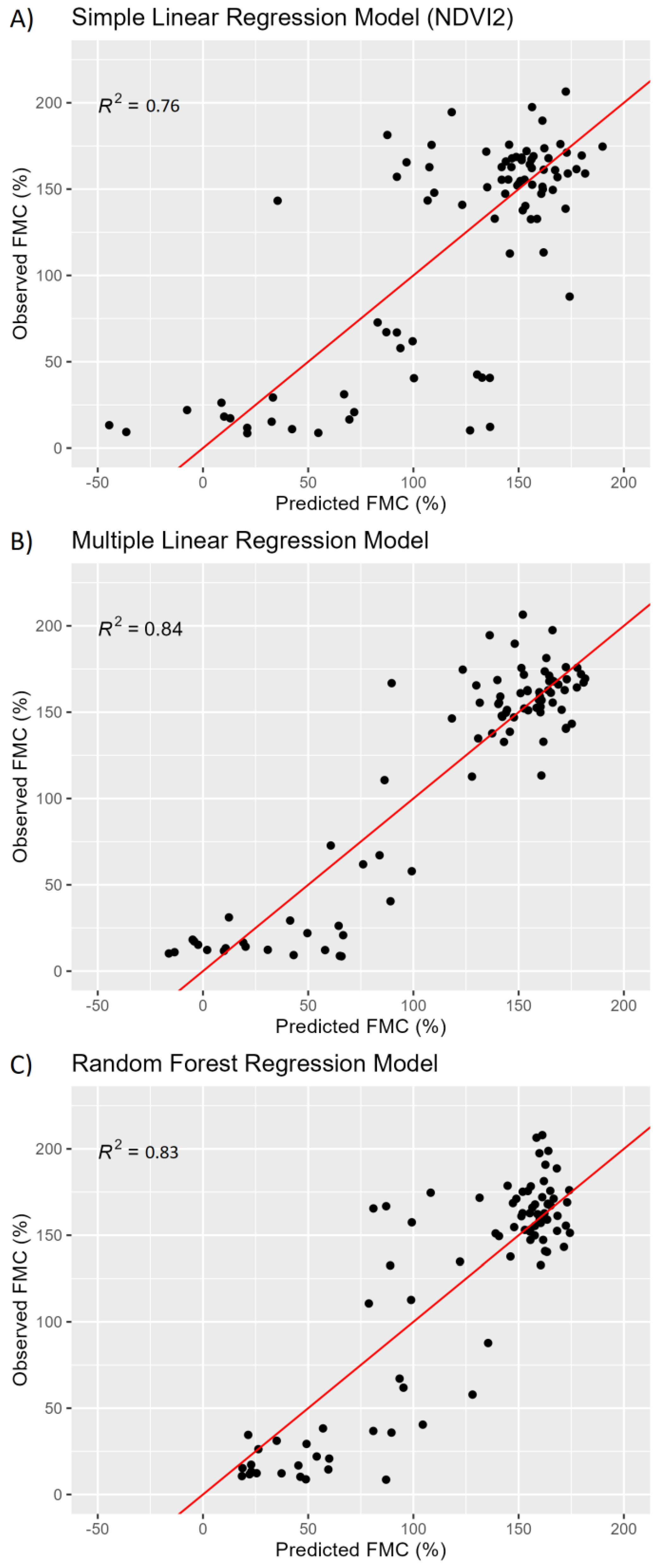Evaluating Predictive Models of Tree Foliar Moisture Content for Application to Multispectral UAS Data: A Laboratory Study
Abstract
:1. Introduction
2. Materials and Methods
2.1. Saplings and Study Treatments
2.2. Data Collection and Processing
2.3. Model Development
3. Results
3.1. Foliar Moisture and Spectral Variation
3.2. Classification Models
3.3. Regression Models
4. Discussion
5. Conclusions
Author Contributions
Funding
Data Availability Statement
Conflicts of Interest
References
- Keyes, C.R. Foliar Moisture Contents of North American Conifers. In Fuels Management-How to Measure Success: Conference Proceedings, Portland, OR, USA, 28–30 March 2006; Proceedings RMRS-P-41; Andrews, P.L., Butler, B.W., Eds.; U.S. Department of Agriculture, Forest Service, Rocky Mountain Research Station: Fort Collins, CO, USA, 2006; pp. 395–399. [Google Scholar]
- Martin-Stpaul, N.; Ruffault, J.; Pimont, F.; Dupuy, J. Chapter 2-Fuel Management Live Fuel Moisture Content: Variability, Predictability and Impact on Fire Behavior and Activity. In Advances in Forest Fire Research 2018; Coimbra University Press: Coimbra, Portugal, 2018. [Google Scholar]
- Jolly, W.; Johnson, D. Pyro-Ecophysiology: Shifting the Paradigm of Live Wildland Fuel Research. Fire 2018, 1, 8. [Google Scholar] [CrossRef]
- Jolly, W.M.; Hadlow, A.M. A Comparison of Two Methods for Estimating Conifer Live Foliar Moisture Content. Int. J. Wildland Fire 2012, 21, 180. [Google Scholar] [CrossRef]
- McNichol, B.H.; Clarke, S.R.; Faccoli, M.; Montes, C.R.; Nowak, J.T.; Reeve, J.D.; Gandhi, K.J.K. 6—Relationships between Drought, Coniferous Tree Physiology, and Ips Bark Beetles under Climatic Changes. In Bark Beetle Management, Ecology, and Climate Change; Gandhi, K.J.K., Hofstetter, R.W., Eds.; Academic Press: Cambridge, MA, USA, 2022; pp. 153–194. ISBN 978-0-12-822145-7. [Google Scholar]
- Hansen, M.E.; Bentz, B.J.; Vandygriff, J.C.; Garza, C. Factors associated with bark beetle infestations of Colorado Plateau ponderosa pine using repeatedly-measured field plots. For. Ecol. Manag. 2023, 545, 121307. [Google Scholar] [CrossRef]
- Smith, A.M.S.; Kolden, C.A.; Tinkham, W.T.; Talhelm, A.F.; Marshall, J.D.; Hudak, A.T.; Boschetti, L.; Falkowski, M.J.; Greenberg, J.A.; Anderson, J.W.; et al. Remote Sensing the Vulnerability of Vegetation in Natural Terrestrial Ecosystems. Remote Sens. Environ. 2014, 154, 322–337. [Google Scholar] [CrossRef]
- Partelli-Feltrin, R.; Johnson, D.M.; Sparks, A.M.; Adams, H.D.; Kolden, C.A.; Nelson, A.S.; Smith, A.M.S. Drought Increases Vulnerability of Pinus Ponderosa Saplings to Fire-Induced Mortality. Fire 2020, 3, 56. [Google Scholar] [CrossRef]
- Robbins, Z.J.; Xu, C.; Aukema, B.H.; Buotte, P.C.; Chitra-Tarak, R.; Fettig, C.J.; Goulden, M.L.; Goodsman, D.W.; Hall, A.D.; Koven, C.D.; et al. Warming Increased Bark Beetle-Induced Tree Mortality by 30% during an Extreme Drought in California. Glob. Change Biol. 2022, 28, 509–523. [Google Scholar] [CrossRef]
- Smith, A.M.S.; Tinkham, W.T.; Roy, D.P.; Boschetti, L.; Kremens, R.L.; Kumar, S.S.; Sparks, A.M.; Falkowski, M.J. Quantification of Fuel Moisture Effects on Biomass Consumed Derived from Fire Radiative Energy Retrievals. Geophys. Res. Lett. 2013, 40, 6298–6302. [Google Scholar] [CrossRef]
- Robichaud, P.R.; Gasvoda, D.S.; Hungerford, R.D.; Bilskie, J.; Ashmun, L.E.; Reardon, J. Measuring Duff Moisture Content in the Field Using a Portable Meter Sensitive to Dielectric Permittivity. Int. J. Wildland Fire 2004, 13, 343. [Google Scholar] [CrossRef]
- Hyde, J.C.; Smith, A.M.S.; Ottmar, R.D. Properties Affecting the Consumption of Sound and Rotten Coarse Woody Debris in Northern Idaho: A Preliminary Investigation Using Laboratory Fires. Int. J. Wildland Fire 2012, 21, 596. [Google Scholar] [CrossRef]
- Talhelm, A.F.; Smith, A.M.S. Litter Moisture Adsorption Is Tied to Tissue Structure, Chemistry, and Energy Concentration. Ecosphere 2018, 9, e02198. [Google Scholar] [CrossRef]
- Chuvieco, E.; Cocero, D.; Aguado, I.; Palacios, A.; Prado, E. Improving Burning Efficiency Estimates through Satellite Assessment of Fuel Moisture Content. J. Geophys. Res. Atmos. 2004, 109, D14S07. [Google Scholar] [CrossRef]
- Gao, B. NDWI—A Normalized Difference Water Index for Remote Sensing of Vegetation Liquid Water from Space. Remote Sens. Environ. 1996, 58, 257–266. [Google Scholar] [CrossRef]
- McFeeters, S.K. The Use of the Normalized Difference Water Index (NDWI) in the Delineation of Open Water Features. Int. J. Remote Sens. 1996, 17, 1425–1432. [Google Scholar] [CrossRef]
- Meingast, K.M.; Falkowski, M.J.; Kane, E.S.; Potvin, L.R.; Benscoter, B.W.; Smith, A.M.S.; Bourgeau-Chavez, L.L.; Miller, M.E. Spectral Detection of Near-Surface Moisture Content and Water-Table Position in Northern Peatland Ecosystems. Remote Sens. Environ. 2014, 152, 536–546. [Google Scholar] [CrossRef]
- Stimson, H.C.; Breshears, D.D.; Ustin, S.L.; Kefauver, S.C. Spectral Sensing of Foliar Water Conditions in Two Co-Occurring Conifer Species: Pinus Edulis and Juniperus Monosperma. Remote Sens. Environ. 2005, 96, 108–118. [Google Scholar] [CrossRef]
- Eitel, J.U.H.; Vierling, L.A.; Litvak, M.E.; Long, D.S.; Schulthess, U.; Ager, A.A.; Krofcheck, D.J.; Stoscheck, L. Broadband, Red-Edge Information from Satellites Improves Early Stress Detection in a New Mexico Conifer Woodland. Remote Sens. Environ. 2011, 115, 3640–3646. [Google Scholar] [CrossRef]
- Seong, N.; Seo, M.; Lee, K.-S.; Lee, C.; Kim, H.; Choi, S.; Han, K.-S. A Water Stress Evaluation over Forest Canopy Using NDWI in Korean Peninsula. Korean J. Remote Sens. 2015, 31, 77–83. [Google Scholar] [CrossRef]
- Roberts, D.A.; Dennison, P.E.; Peterson, S.H.; Rechel, J. Use of Normalized Difference Water Index for Monitoring Live Fuel Moisture. Int. J. Remote Sens. 2006, 26, 1035–1042. [Google Scholar] [CrossRef]
- Sparks, A.; Kolden, C.; Talhelm, A.; Smith, A.; Apostol, K.; Johnson, D.; Boschetti, L. Spectral Indices Accurately Quantify Changes in Seedling Physiology Following Fire: Towards Mechanistic Assessments of Post-Fire Carbon Cycling. Remote Sens. 2016, 8, 572. [Google Scholar] [CrossRef]
- Gamon, J.A.; Peñuelas, J.; Field, C.B. A Narrow-Waveband Spectral Index That Tracks Diurnal Changes in Photosynthetic Efficiency. Remote Sens. Environ. 1992, 41, 35–44. [Google Scholar] [CrossRef]
- Sparks, A.M.; Blanco, A.S.; Wilson, D.R.; Schwilk, D.W.; Johnson, D.M.; Adams, H.D.; Bowman, D.M.J.S.; Hardman, D.D.; Smith, A.M.S. Fire Intensity Impacts on Physiological Performance and Mortality in Pinus monticola and Pseudotsuga menziesii Saplings: A Dose–Response Analysis. Tree Physiol. 2023, 43, 1365–1382. [Google Scholar] [CrossRef] [PubMed]
- Pérez-Rodríguez, L.A.; Quintano, C.; García-Llamas, P.; Fernández-García, V.; Taboada, A.; Fernández-Guisuraga, J.M.; Marcos, E.; Suárez-Seoane, S.; Calvo, L.; Fernández-Manso, A. Using Unmanned Aerial Vehicles (UAV) for Forest Damage Monitoring in South-Western Europe. In Imaging Spectrometry XXIII: Applications, Sensors, and Processing; SPIE: Bellingham, WA, USA, 2019. [Google Scholar]
- Swayze, N.C.; Tinkham, W.T.; Vogeler, J.C.; Hudak, A.T. Influence of Flight Parameters on UAS-Based Monitoring of Tree Height, Diameter, and Density. Remote Sens. Environ. 2021, 263, 112540. [Google Scholar] [CrossRef]
- MicaSense. Available online: https://micasense.com/dual-camera-system/ (accessed on 15 September 2020).
- European Space Agency. Available online: https://sentinel.esa.int/web/sentinel/user-guides/sentinel-2-msi/resolutions/spectral (accessed on 17 March 2023).
- Dash, J.P.; Watt, M.S.; Pearse, G.D.; Heaphy, M.; Dungey, H.S. Assessing Very High Resolution UAV Imagery for Monitoring Forest Health during a Simulated Disease Outbreak. ISPRS J. Photogramm. Remote Sens. 2017, 131, 1–14. [Google Scholar] [CrossRef]
- Fraser, B.T.; Congalton, R.G. Monitoring Fine-Scale Forest Health Using Unmanned Aerial Systems (UAS) Multispectral Models. Remote Sens. 2021, 13, 4873. [Google Scholar] [CrossRef]
- D’Odorico, P.; Schönbeck, L.; Vitali, V.; Meusburger, K.; Schaub, M.; Ginzler, C.; Zweifel, R.; Velasco, V.M.E.; Gisler, J.; Gessler, A.; et al. Drone-Based Physiological Index Reveals Long-Term Acclimation and Drought Stress Responses in Trees. Plant Cell Environ. 2021, 44, 3552–3570. [Google Scholar] [CrossRef]
- Smith, A.M.S.; Sparks, A.M.; Kolden, C.A.; Abatzoglou, J.T.; Talhelm, A.F.; Johnson, D.M.; Boschetti, L.; Lutz, J.A.; Apostol, K.G.; Yedinak, K.M.; et al. Towards a New Paradigm in Fire Severity Research Using Dose–Response Experiments. Int. J. Wildland Fire 2016, 25, 158. [Google Scholar] [CrossRef]
- Trigg, S.; Flasse, S. An Evaluation of Different Bi-Spectral Spaces for Discriminating Burned Shrub-Savannah. Int. J. Remote Sens. 2001, 22, 2641–2647. [Google Scholar] [CrossRef]
- Smith, A.M.S.; Wooster, M.J.; Drake, N.A.; Dipotso, F.M.; Falkowski, M.J.; Hudak, A.T. Testing the Potential of Multi-Spectral Remote Sensing for Retrospectively Estimating Fire Severity in African Savannahs. Remote Sens. Environ. 2005, 97, 92–115. [Google Scholar] [CrossRef]
- Rouse, J.W.; Haas, R.H.; Schell, J.A.; Deering, D.W. Monitoring Vegetation Systems in the Great Plains with ERTS. NASA Spec. Publ. 1974, 351, 309. [Google Scholar]
- Perez Castillo, C.J. Determination of Biophysical Variables Using Remote Sensing Techniques. Ph.D. Thesis, The University of Nebraska—Lincoln, Lincoln, NE, USA, 1998. [Google Scholar]
- Kostrzewski, M.A. Determining the Feasibility of Collecting High-Resolution Ground-Based Remotely Sensed Data and Issues of Scale for Use in Agriculture. Ph.D. Thesis, The University of Arizona, Tucson, AZ, USA, 2000. [Google Scholar]
- Shibayama, M.; Salli, A.; Häme, T.; Iso-Iivari, L.; Heino, S.; Alanen, M.; Morinaga, S.; Inoue, Y.; Akiyama, T. Detecting Phenophases of Subarctic Shrub Canopies by Using Automated Reflectance Measurements. Remote Sens. Environ. 1999, 67, 160–180. [Google Scholar] [CrossRef]
- Gamon, J.A.; Serrano, L.; Surfus, J.S. The Photochemical Reflectance Index: An Optical Indicator of Photosynthetic Radiation Use Efficiency across Species, Functional Types, and Nutrient Levels. Oecologia 1997, 112, 492–501. [Google Scholar] [CrossRef]
- Liaw, A.; Wiener, M. Classification and Regression by randomForest. R News 2002, 2, 18–22. [Google Scholar]
- R: A Language and Environment for Statistical Computing. Available online: https://www.R-project.org/ (accessed on 15 January 2022).
- Genuer, R.; Poggi, J.-M.; Tuleau-Malot, C. Variable Selection Using Random Forests. Pattern Recognit. Lett. 2010, 31, 2225–2236. [Google Scholar] [CrossRef]
- Live Fuel Moisture Content (NWCG). Available online: https://www.nwcg.gov/publications/pms437/fuel-moisture/live-fuel-moisture-content (accessed on 15 November 2021).
- Fire Behavior Field Reference Guide, PMS 437|NWCG. Available online: https://www.nwcg.gov/publications/pms437 (accessed on 15 November 2022).
- Venables, B.; Ripley, B. Modern Applied Statistics with S; Springer: Berlin/Heidelberg, Germany, 2002. [Google Scholar]
- Olsrr: Tools for Building OLS Regression Models. Available online: https://CRAN.R-project.org/package=olsrr (accessed on 17 March 2023).
- McFadden, D. Regression-Based Specification Tests for the Multinomial Logit Model. J. Econom. 1987, 34, 63–82. [Google Scholar] [CrossRef]
- Blanco, V.; Blaya-Ros, P.J.; Castillo, C.; Soto-Vallés, F.; Torres-Sánchez, R.; Domingo, R. Potential of UAS-Based Remote Sensing for Estimating Tree Water Status and Yield in Sweet Cherry Trees. Remote Sens. 2020, 12, 2359. [Google Scholar] [CrossRef]
- Ndlovu, H.S.; Odindi, J.; Sibanda, M.; Mutanga, O.; Clulow, A.; Chimonyo, V.G.P.; Mabhaudhi, T. A Comparative Estimation of Maize Leaf Water Content Using Machine Learning Techniques and Unmanned Aerial Vehicle (UAV)-Based Proximal and Remotely Sensed Data. Remote Sens. 2021, 13, 4091. [Google Scholar] [CrossRef]
- Yebra, M.; Chuvieco, E.; Riaño, D. Estimation of Live Fuel Moisture Content from MODIS Images for Fire Risk Assessment. Agric. For. Meteorol. 2008, 148, 523–536. [Google Scholar] [CrossRef]
- Hunt, E.R., Jr.; Wang, L.; Qu, J.J.; Hao, X. Remote Sensing of Fuel Moisture Content from Canopy Water Indices and Normalized Dry Matter Index. JARS 2012, 6, 061705. [Google Scholar] [CrossRef]
- Urban, M.; Berger, C.; Mudau, T.E.; Heckel, K.; Truckenbrodt, J.; Onyango Odipo, V.; Smit, I.P.J.; Schmullius, C. Surface Moisture and Vegetation Cover Analysis for Drought Monitoring in the Southern Kruger National Park Using Sentinel-1, Sentinel-2, and Landsat-8. Remote Sens. 2018, 10, 1482. [Google Scholar] [CrossRef]
- Hu, X.; Ren, H.; Tansey, K.; Zheng, Y.; Ghent, D.; Liu, X.; Yan, L. Agricultural Drought Monitoring Using European Space Agency Sentinel 3A Land Surface Temperature and Normalized Difference Vegetation Index Imageries. Agric. For. Meteorol. 2019, 279, 107707. [Google Scholar] [CrossRef]
- Wang, L.; Quan, X.; He, B.; Yebra, M.; Xing, M.; Liu, X. Assessment of the Dual Polarimetric Sentinel-1A Data for Forest Fuel Moisture Content Estimation. Remote Sens. 2019, 11, 1568. [Google Scholar] [CrossRef]
- Kaiser, P.; Buddenbaum, H.; Nink, S.; Hill, J. Potential of Sentinel-1 Data for Spatially and Temporally High-Resolution Detection of Drought Affected Forest Stands. Forests 2022, 13, 2148. [Google Scholar] [CrossRef]
- Shorachi, M.; Kumar, V.; Steele-Dunne, S.C. Sentinel-1 SAR Backscatter Response to Agricultural Drought in The Netherlands. Remote Sens. 2022, 14, 2435. [Google Scholar] [CrossRef]
- Hernández-Clemente, R.; Navarro-Cerrillo, R.M.; Suárez Barranco, M.D.; Morales Iribas, F.; Zarco-Tejada, P.J. Assessing Structural Effects on PRI for Stress Detection in Conifer Forests. Remote Sens. Environ. 2011, 115, 2360–2375. [Google Scholar] [CrossRef]
- Ollinger, S.V. Sources of Variability in Canopy Reflectance and the Convergent Properties of Plants. New Phytol. 2011, 189, 375–394. [Google Scholar] [CrossRef]
- Baeza, M.J.; De Luís, M.; Raventós, J.; Escarré, A. Factors Influencing Fire Behaviour in Shrublands of Different Stand Ages and the Implications for Using Prescribed Burning to Reduce Wildfire Risk. J. Environ. Manag. 2002, 65, 199–208. [Google Scholar] [CrossRef]
- Kolb, T.; Keefover-Ring, K.; Burr, S.J.; Hofstetter, R.; Gaylord, M.; Raffa, K.F. Drought-Mediated Changes in Tree Physiological Processes Weaken Tree Defenses to Bark Beetle Attack. J. Chem. Ecol. 2019, 45, 888–900. [Google Scholar] [CrossRef]
- Creasy, M.B.; Tinkham, W.T.; Hoffman, C.M.; Vogeler, J.C. Potential for individual tree monitoring in ponderosa pine-dominated forests using unmanned aerial system structure from motion point clouds. Can. J. For. Res. 2021, 51, 1093–1105. [Google Scholar] [CrossRef]




| Species | Control—0 Days | Group 1—14 Day Drought | Group 2—19 Day Drought | Group 3—25 Day Drought | ||||
|---|---|---|---|---|---|---|---|---|
| FMC (%) | Sample Size | FMC (%) | Sample Size | FMC (%) | Sample Size | FMC (%) | Sample Size | |
| western white pine | 173.69 (17.61) | 14 | 168.78 (19.97) | 16 | 158.25 (18.33) | 16 | 52.40 (55.09) | 16 |
| Douglas-fir | 148.90 (10.47) | 13 | 158.53 (19.32) | 16 | 103.23 (57.62) | 16 | 19.92 (15.70) | 16 |
| Index | Index Name | Equation | Main Application |
|---|---|---|---|
| NDVI | Normalized Difference Vegetation Index | (NIR − Red)/(NIR + Red) | Chlorophyll content/Plant greenness [35] |
| NDVI2 | Normalized Difference Vegetation Index 2 | (NIR − Red2)/(NIR + Red2) | Not commonly used; Chlorophyll content/Plant greenness |
| GNDVI | Green Normalized Difference Vegetation Index | (NIR − Green)/(NIR + Green) | Photosynthetic activity/ greenness [36] |
| GNDVI2 | Green Normalized Difference Vegetation Index 2 | (NIR − Green2)/(NIR + Green2) | Not commonly used |
| NDRE | Normalized Difference Red Edge | (NIR − Red Edge1)/(NIR + Red Edge1) | Plant health of mature plants [37] |
| GRVI | Green Ratio Vegetation Index | NIR/Green | Phenological indicator [38] |
| NDWI | Normalized Difference Water Index | (Green − NIR)/(Green + NIR) | Water content of water bodies [16] |
| PRI | Physiological Reflectance Index | (Green2 − Green)/(Green2 + Green) | Crop health monitoring [39] |
| FMCI | Foliar Moisture Content Index | (Red Edge3 − NIR)/(Red Edge3 + NIR) | Developed for this study |
| Random Forest | Reference Class | |||
|---|---|---|---|---|
| Drought-Stressed | Healthy | Commission Error | ||
| Predicted Class | Drought-Stressed | 10 | 1 | 9.09% |
| Healthy | 1 | 24 | 4.00% | |
| Omission Error | 9.09% | 4.00% | ||
| Logistic Regression | ||||
| Predicted Class | Drought-Stressed | 11 | 0 | 0.00% |
| Healthy | 1 | 24 | 4.00% | |
| Omission Error | 8.33% | 0.00% | ||
| Coefficient | Standard Error | Z-Value | p-Value | |
|---|---|---|---|---|
| Intercept | 43.63 | 18.07 | 2.41 | <0.05 |
| NDVI2 | −11.68 | 7.50 | −1.55 | 0.12 |
| Red edge 3 | −89.16 | 39.14 | −2.28 | <0.05 |
| FMCI | −115.01 | 53.35 | −2.16 | <0.05 |
| PRI | −147.73 | 56.94 | −2.60 | <0.05 |
| Predictor Variable | Intercept | Coefficient (SE) | p-Value | Residual Standard Error | Adjusted r2 |
|---|---|---|---|---|---|
| NDVI2 | 13.17 | 267.66 (17.47) | <0.05 | 33.08 | 73.41 |
| Red edge 3 | −135.46 | 1504.39 (223.94) | <0.05 | 52.32 | 33.91 |
| FMCI | 28.13 | 375.90 (323.54) | 0.25 | 63.18 | 0.41 |
| PRI | 158.16 | 1732.76 (255.01) | <0.05 | 52.12 | 34.44 |
| Species | 101.56 | 36.28 (13.19) | <0.05 | 61.52 | 7.09 |
| Coefficient | Standard Error | T Value | p-Value | AIC | |
|---|---|---|---|---|---|
| Intercept | −226.61 | 41.18 | −5.50 | <0.05 | - |
| NDVI2 | 138.64 | 21.39 | 6.48 | <0.05 | 860.96 |
| Red edge 3 | 611.92 | 149.30 | 4.10 | <0.05 | 850.84 |
| FMCI | 851.31 | 159.19 | 5.38 | <0.05 | 833.78 |
| PRI | 1039.63 | 202.10 | 5.14 | <0.05 | 854.59 |
Disclaimer/Publisher’s Note: The statements, opinions and data contained in all publications are solely those of the individual author(s) and contributor(s) and not of MDPI and/or the editor(s). MDPI and/or the editor(s) disclaim responsibility for any injury to people or property resulting from any ideas, methods, instructions or products referred to in the content. |
© 2023 by the authors. Licensee MDPI, Basel, Switzerland. This article is an open access article distributed under the terms and conditions of the Creative Commons Attribution (CC BY) license (https://creativecommons.org/licenses/by/4.0/).
Share and Cite
Lad, L.E.; Tinkham, W.T.; Sparks, A.M.; Smith, A.M.S. Evaluating Predictive Models of Tree Foliar Moisture Content for Application to Multispectral UAS Data: A Laboratory Study. Remote Sens. 2023, 15, 5703. https://doi.org/10.3390/rs15245703
Lad LE, Tinkham WT, Sparks AM, Smith AMS. Evaluating Predictive Models of Tree Foliar Moisture Content for Application to Multispectral UAS Data: A Laboratory Study. Remote Sensing. 2023; 15(24):5703. https://doi.org/10.3390/rs15245703
Chicago/Turabian StyleLad, Lauren E., Wade T. Tinkham, Aaron M. Sparks, and Alistair M. S. Smith. 2023. "Evaluating Predictive Models of Tree Foliar Moisture Content for Application to Multispectral UAS Data: A Laboratory Study" Remote Sensing 15, no. 24: 5703. https://doi.org/10.3390/rs15245703
APA StyleLad, L. E., Tinkham, W. T., Sparks, A. M., & Smith, A. M. S. (2023). Evaluating Predictive Models of Tree Foliar Moisture Content for Application to Multispectral UAS Data: A Laboratory Study. Remote Sensing, 15(24), 5703. https://doi.org/10.3390/rs15245703









